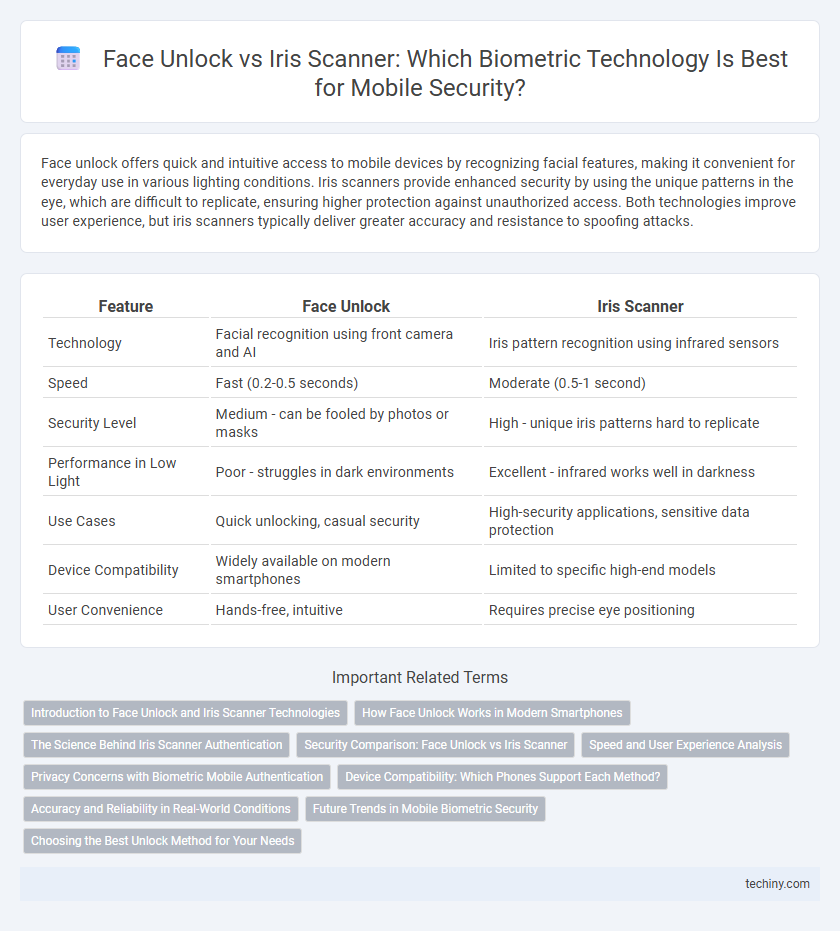Face unlock offers quick and intuitive access to mobile devices by recognizing facial features, making it convenient for everyday use in various lighting conditions. Iris scanners provide enhanced security by using the unique patterns in the eye, which are difficult to replicate, ensuring higher protection against unauthorized access. Both technologies improve user experience, but iris scanners typically deliver greater accuracy and resistance to spoofing attacks.
Table of Comparison
| Feature | Face Unlock | Iris Scanner |
|---|---|---|
| Technology | Facial recognition using front camera and AI | Iris pattern recognition using infrared sensors |
| Speed | Fast (0.2-0.5 seconds) | Moderate (0.5-1 second) |
| Security Level | Medium - can be fooled by photos or masks | High - unique iris patterns hard to replicate |
| Performance in Low Light | Poor - struggles in dark environments | Excellent - infrared works well in darkness |
| Use Cases | Quick unlocking, casual security | High-security applications, sensitive data protection |
| Device Compatibility | Widely available on modern smartphones | Limited to specific high-end models |
| User Convenience | Hands-free, intuitive | Requires precise eye positioning |
Introduction to Face Unlock and Iris Scanner Technologies
Face unlock technology uses advanced facial recognition algorithms combined with front-facing cameras and infrared sensors to quickly and securely identify users by mapping facial features. Iris scanners employ near-infrared light and high-resolution cameras to capture the unique patterns of the iris, offering highly accurate biometric authentication even in low-light conditions. Both technologies enhance mobile security, with face unlock providing convenience and iris scanners delivering precision for device access control.
How Face Unlock Works in Modern Smartphones
Face unlock in modern smartphones uses advanced 3D mapping technology, combining infrared sensors and structured light to create a detailed facial map for secure authentication. This biometric system captures depth and contour data, ensuring accuracy even in varying lighting conditions and preventing spoofing through 2D images. Integration with machine learning algorithms allows continuous improvement in recognition speed and precision, enhancing user convenience and device security.
The Science Behind Iris Scanner Authentication
Iris scanner authentication uses near-infrared light to capture the unique patterns of the iris, which are then converted into a digital biometric template for high-precision user verification. Unlike face unlock technology that relies on visible light to map facial features, iris scanning analyzes the intricate structures within the colored part of the eye, offering superior accuracy and resistance to spoofing. This biometric method leverages the stability and uniqueness of the iris pattern, making it a highly secure choice for mobile device authentication.
Security Comparison: Face Unlock vs Iris Scanner
Face unlock technology leverages 3D facial recognition and infrared sensors to provide quick and convenient access, but it can be vulnerable to high-quality images or masks. Iris scanners offer enhanced security by analyzing unique patterns in the colored ring of the eye, making spoofing extremely difficult and reducing false acceptance rates significantly. In terms of biometric security, iris scanning consistently delivers higher accuracy and resistance to fraud compared to face unlock systems.
Speed and User Experience Analysis
Face unlock offers faster authentication times, usually under one second, enhancing user convenience during frequent device access. Iris scanner technology provides higher security but tends to be slower, often requiring precise positioning and ambient light conditions, which can affect the user experience negatively. Users prioritize speed and ease of use, making face unlock the preferred choice for everyday mobile device interactions.
Privacy Concerns with Biometric Mobile Authentication
Face unlock systems capture and store detailed facial data, raising concerns about potential misuse or unauthorized access, while iris scanners utilize unique eye patterns that are harder to replicate but still vulnerable to sophisticated spoofing attacks. Both biometric methods face privacy challenges related to data storage, encryption standards, and user consent, highlighting the need for robust security protocols and transparent data handling policies. Mobile devices must implement end-to-end encryption and local biometric data processing to minimize risks of identity theft and unauthorized surveillance.
Device Compatibility: Which Phones Support Each Method?
Face unlock is widely supported across Android and iOS devices, especially on mid-range to flagship models from brands like Samsung, Apple, and OnePlus. Iris scanner technology is more limited in compatibility, primarily found on select Samsung Galaxy devices such as the Galaxy S9 and Note 9 series. Face unlock offers broader device compatibility, while iris scanners remain niche, often requiring specialized hardware not present in most modern smartphones.
Accuracy and Reliability in Real-World Conditions
Face unlock technology offers swift and convenient authentication but may struggle with accuracy in low-light or visually obstructed environments. Iris scanners deliver higher precision by analyzing unique patterns in the eye, maintaining reliability even in challenging lighting or with partial face coverage. Studies indicate iris recognition achieves error rates below 1%, outperforming face unlock systems, which can have increased false acceptance or rejection under varying real-world conditions.
Future Trends in Mobile Biometric Security
Face unlock and iris scanner technologies are evolving rapidly, with AI-driven algorithms enhancing accuracy and speed for mobile biometric security. Future trends indicate increased integration of multimodal biometrics, combining facial recognition, iris scanning, and voice patterns to enhance security and user convenience. Advancements in deep learning and 3D imaging will drive more secure, anti-spoofing mechanisms, making mobile device authentication more robust against sophisticated cyber threats.
Choosing the Best Unlock Method for Your Needs
Face unlock offers fast and convenient access using facial recognition technology, ideal for everyday use and quick device access. Iris scanners provide higher security and accuracy by analyzing unique patterns in the eye, suitable for users prioritizing data protection. Selecting the best unlock method depends on balancing convenience and security requirements based on individual preferences and device capabilities.
Face unlock vs iris scanner Infographic

 techiny.com
techiny.com